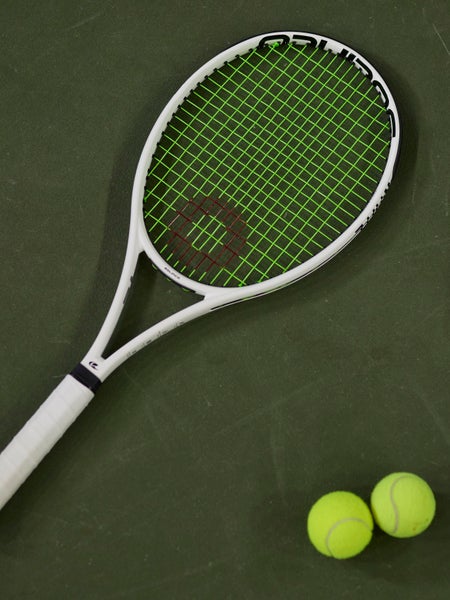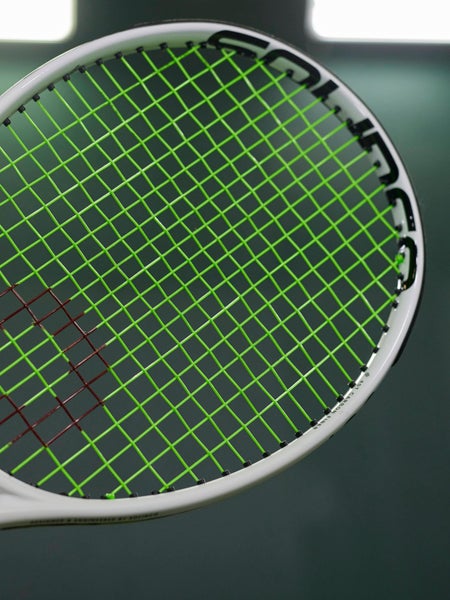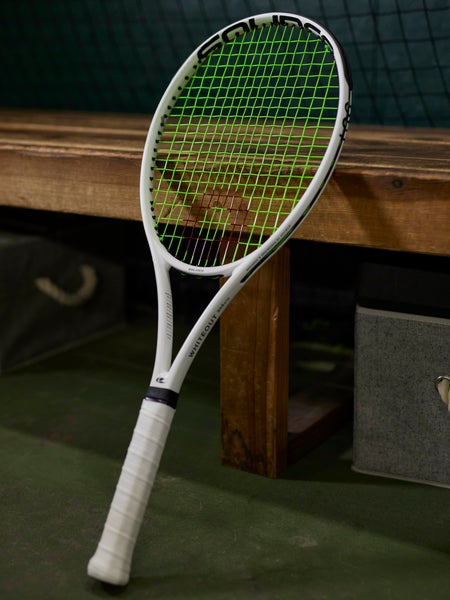Solinco Whiteout 305 XTD Racquet Review
| Overall | 84 |
|---|---|
| Groundstrokes | 86 |
| Volleys | 84 |
| Serves | 90 |
| Returns | 81 |
| Power | 88 |
| Control | 80 |
| Maneuverability | 76 |
| Stability | 87 |
| Comfort | 77 |
| Touch/Feel | 78 |
| Topspin | 84 |
| Slice | 85 |
As tennis enthusiasts, you can imagine our delight when Solinco confirmed it was making extended versions of the Whiteout and Blackout racquets. We gathered up our playtesters who have a soft spot in their hearts for extended racquets to put the Whiteout 305 XTD to the test. Our team spent a good amount of time on the court with the standard-length version of this racquet, and with the extra half inch on the XTD version, they instantly found loads of power and plow through. With identical technologies to the standard racquet, and even the same static weight, this Whiteout 305 XTD felt solid and firm without being uncomfortable. Because it has a hefty swingweight that pushes past 330, our crew was excited to be able to customize it with the Solinco weighted butt caps to create a more head-light racquet that better suited their preferences. While everyone appreciated what it had to offer from all areas of the court, all four of our playtesters agreed that this racquet enhanced their serves and felt nearly flawless at net.
Upsides
- Stability
- Plow through
Downsides
- We couldn't agree on any
Groundstrokes - Score: 86
Chris preferred the response of the Whiteout 305 XTD on groundstrokes over the standard-length model. He began, "The added length and swingweight gave my shots more drive as opposed to the loopier response I found from the standard Whiteout. I was able to better find my targets and much preferred the response on my backhand slice. I had very good results driving that shot with depth and pace. My topspin backhand was also working well with seemingly effortless access to pace and depth. My forehands were pushing through the court nicely, and I was hitting a heavy ball. The general feel of the racquet in my hand had me more dialed in, and I had way more confidence with this longer version. I'd love to try it with an 18x20 string pattern for even more precision."
When Troy started swinging this racquet from the baseline he found the maneuverability and plow through to feel very familiar. He explained, "The specs of this Whiteout 305 XTD are almost identical to the specs of my Yonex EZONE 98+ and the Yonex VCORE 98+ that I play with quite frequently. I was able to time my shots well, and the racquet felt almost like an extension of my arm. The feel on contact was on the firm side for my preferences. There was a firmer, crisper feel when comparing it directly to my EZONE 98+. As I mentioned in the standard-length Whiteout 305 review, the feel reminded me of the Babolat Pure Strike 16x19 or Tecnifibre TFight 315 RS. The open 16x19 string pattern allowed me to ramp up the spin when I needed to, but I also found decent control when flattening out my forehands. On the other hand, when I was hitting my backhand slice, I found the ball to sit up more than I would have liked, which is something I tend to find from more open string patterns."
"After playtesting the standard-length Whiteout 305, I knew I would love what the extended version had to offer," said Michelle. "Right off the bat, I found the swingweight to be bumped up, and even though it was just a few points higher than the standard-length racquet, it required a bit more from me to swing effectively. As I hit with it more from the baseline I started to effectively time my shots and stopped making the mistake of being late. Initially, I was a bit wary to take it into match play, but once I started point play with this racquet in hand, the playtest really began for me. The Whiteout 305 quickly became a weapon in my hands, and if I struck the ball at the right time, I was hitting my targets and getting balls deep, so deep that several people told me my shots were pushing them back, and they had no play or defense. It was awesome! I found myself going for offensive shots 90 percent of the time; even in side-to-side rallies, I could effectively drill balls down the line rather than go safe and cross court. This is exactly how a racquet falls into the 'guilty pleasure' category, because although I should be playing a bit safer and constructing points smarter, I felt entitled to go big, hit hard and keep my foot on the gas. The racquet felt predictable and gave me a good sense of control and precision even when I went for big shots. The one downside was that the sweetspot did feel a bit smaller than the regular-length version. Overall, I leaned into the quick-strike tennis I could play with this racquet."
It took Mark a full hour of play before he felt like he could effectively manage all the easy power the Solinco Whiteout 305 XTD afforded from the baseline, but once he did, this racquet really clicked with his playstyle. He said, "The tradeoff between using the standard-length Whiteout 305 and this extended model was that I needed to prepare my backswing earlier with the 27.5-inch length to get the reward, which was realistic groundstroke power from one baseline to the other. Changing the direction of the ball and absorbing pace is my thing from the backcourt, and it seems as if the Whiteout 305 XTD was made for precisely that!"

Volleys - Score: 84
Our playtesters were pleased with the stability, control and predictability of the Whiteout 305 XTD when hitting volleys. As he noted on his groundstroke comments, Troy also found a firmer feel at net. He said, "When going for my targets, it felt very point-and-shoot, and the ball was in and out of contact quickly; I could locate those targets rather easily. I didn't have an issue with the maneuverability of this extended racquet, but I liked how it maneuvered better after adding weight to the handle. It felt much more to my liking after installing the Solinco Weighted Butt Cap for 10 grams of additional handle weight. With this added weight to the handle, the maneuverability felt closer to my tail-weighted Yonex EZONE 98+."
For Mark, the forehand volley is the one shot that challenges him when playing with extended-length racquets. He explained, "It's because I have to get out of the way of myself if I decide to hit a forehand volley, but once I sorted that out and capitalized on my backhand volley more often, this racquet did the rest of the work for me at net. The weight and length provided zero fuss (ample stability), along with minimal vibration, even if ball contact was outside the stringbed and on the frame."
"This racquet was super solid at net," added Michelle. "Despite it feeling a bit demanding from time to time at the baseline, at net the racquet maneuvered into position quite well and blocked balls back seamlessly. I really enjoyed volleying with this racquet. Truth be told, I didn't make it to the net a ton during this playtest because this racquet allowed me to finish points fast with my serve and next shot tactics."
As from the baseline, Chris enjoyed the more stable feel of this racquet. He said, "My volleys felt rock solid. I was able to punch volleys away with good pace and penetration. I liked the stability and power level on stretch volleys. I could still get solid depth on my shots with this racquet even when I didn't feel like I was getting a whole lot behind the ball. My touch shots felt pretty clean too. While this is not a feel racquet in the traditional sense, the response was crisp, clean and connected. I was also able to get ample spin to help volleys drop short."

Serves - Score: 90
Our entire team benefited from the extra length of the Whiteout 305 XTD when serving. Mark was very satisfied with the serves he produced. He said, "I saw my serve improve during this playtest. The more I practiced my serve, the better it became, making it my favorite shot to hit with this racquet. More than most racquets I have played with, this Whiteout 305 XTD seemed to offer me limitless potential on serve."
"The extended length and higher swingweight (compared to the standard-length Whiteout 305), gave this racquet a noticeable boost in power," said Troy. "I loved how fluid and easy it felt when I wanted to go for a big serve down the T. I also found it maneuverable or 'whippy' enough to generate easy spin for kick and slice serves. There was good precision when aiming for my targets. The overall weight of this racquet was relatively light for me, so I could crank up the racquet speed easily. With the extended length, I really felt confident going big on the first serves."
Chris found serving with the Whiteout 305 XTD to be lots of fun. He described, "I was generating lots of pace and spin on my serves with this racquet. My favorite serve was a hard slice serve. I could try and break it wide of my opponent or use it to jam the serve into the body. I felt confident enough to use this serve on both first and second serves with no drawbacks to consistency. My flat serves were also working pretty well, and I felt confident enough to go for that serve more than usual."
Michelle thought the extended length made for lethal serves. She said, "I liked serving with this racquet more than the standard length. It helped provide big, flat first serves, and the racquet moved fluidly through my motion. Kick and spin serves seemed exaggerated too. The extra plow through made the racquet very effective and helped me produce bigger serves. I felt confident hitting a big serve and following it up with a ball behind my opponent or to the open court."

Returns - Score: 81
The combination of the extended reach and easy plow through made the Whiteout 305 XTD a weapon in the hands of our playtesters when going after their returns. Recalling that she enjoyed returning with the standard-length Whiteout 305, Michelle appreciated the added plow through from this extended version. She explained, "There are some racquets that really make it easy to keep the ball out in front and take a more compact backswing, and that happened naturally with this racquet. I could swing big, but with a shorter backswing, and effectively started points on the offensive. It was super fun to return with! I also found it more stable than the standard-length Whiteout 305."
Troy agreed with Michelle, adding, "I loved stepping in and being aggressive when the opportunity presented itself. I felt confident taking a big aggressive rip on my forehand return, and there was enough control to go hard and flat without the ball flying long. As with most extended-length racquets, I was getting easy leverage on my two-handed returns, which resulted in easier depth. I would have liked a bit more of a low-skidding slice, but there was enough plow through for me to chip the ball back with good depth. If I could change one thing on this Whiteout 305 XTD, I would add a slightly softer or smoother feel on contact. For me, it felt borderline on the stiff side of the spectrum. If I was missing the sweetspot or not quite hitting cleanly, the feel was a bit firm for my liking (specifically compared to my Yonex EZONE 98+, which has very similar specs, but with the added comfort)."
"I was surprised to find that the Whiteout 305 XTD felt pretty fast to maneuver on returns," said Chris. "I was able to accelerate the racquet through the ball to generate spin, and getting pace was never an issue. Again, stability was very impressive, giving the racquet a predictable response on chip returns. The Whiteout 305 XTD clicked with my return game, and I felt more confident than I ever did when returning with the standard version. My shots were more direct, and I had much better control over the depth of my ball."
Throughout the playtest, Mark never felt fully confident with the Whiteout 305 XTD's returns. He described, "My return of serve is often more like a half volley rather than a full swing like my groundstrokes. I have the same issue with my returns as I do with my volleys, which is getting out of my own way on the forehand wing. After some practice, I was able to effectively block serves back into play. However, this was the single shot that I never really felt completely dialed in with."
Overall - Score: 84
| Technical Specifications | ||
|---|---|---|
| Length | 27.5 in | 70 cm |
| Head Size | 98 sq in | 632 sq cm |
| Weight | 11.4 oz | 323 gm |
| Balance Point | 13 in 33 cm | 6pts Head Light |
| Construction | 21.7mm/21.7mm/21.7mm | |
| Composition | 40T Cabon/Graphite | |
| String Pattern | 16 Mains / 19 Crosses | |
| Babolat RDC Ratings | ||
|---|---|---|
| Score | Grade | |
| Flex Rating | 67 | Range: 0-100 |
| Swing Weight | 333 | Range: 200-400 |
| Chris' Scores | |||
|---|---|---|---|
| Power | 9.3 | Serves | 9.4 |
| Control | 7.9 | Groundstrokes | 8.4 |
| Maneuverability | 7.8 | Returns | 8.4 |
| Stability | 8.8 | Slice | 8.6 |
| Comfort | 8 | Topspin | 8.7 |
| Touch/Feel | 7.8 | Volleys | 8.5 |
| Overall | 8.4 | ||
| Troy's Scores | |||
|---|---|---|---|
| Power | 8.5 | Serves | 9 |
| Control | 8.2 | Groundstrokes | 8.7 |
| Maneuverability | 7.9 | Returns | 8.3 |
| Stability | 8.7 | Slice | 8.3 |
| Comfort | 7.1 | Topspin | 8.5 |
| Touch/Feel | 8 | Volleys | 8.6 |
| Overall | 8.4 | ||
| Mark's Scores | |||
|---|---|---|---|
| Power | 8.5 | Serves | 9 |
| Control | 8 | Groundstrokes | 9 |
| Maneuverability | 7.5 | Returns | 6.5 |
| Stability | 9 | Slice | 8.5 |
| Comfort | 8 | Topspin | 8.5 |
| Touch/Feel | 8 | Volleys | 8 |
| Overall | 8.2 | ||
| Michelle's Scores | |||
|---|---|---|---|
| Power | 9 | Serves | 8.5 |
| Control | 8 | Groundstrokes | 8.3 |
| Maneuverability | 7 | Returns | 9 |
| Stability | 8.2 | Slice | 8.5 |
| Comfort | 7.8 | Topspin | 7.8 |
| Touch/Feel | 7.5 | Volleys | 8.5 |
| Overall | 8.6 | ||
Playtester Profiles
Chris: 4.5 all-court player currently using the Head Speed Pro 2022. Chris uses a semi-western forehand grip and hits a one-handed backhand.
Troy: 5.0 lefty all-court player with a full Western Forehand and a two-handed backhand. Troy currently plays with a Yonex EZONE 98+.
Mark: 5.0 lefty all-court player with a one-handed backhand. He currently plays with the Head Boom Pro 2022.
Michelle: Open level baseline player with a semi-western forehand and a two handed backhand. She currently plays with the Wilson Pro Staff RF 97 Autograph.












Likes
Chris - "I love the power, the stability and the added weight of shot (plow through) I have with the Whiteout 305 XTD."
Troy - "I enjoy the control and precision, and the extended length offers a nice boost in power on serves. The specs of this racquet are very similar to my racquet of choice, and I like the fact that I can swap out the butt cap for additional tail-weight or easy customization."
Mark - "I feel that my overall shot quality increased. The Whiteout 305 XTD's level of stability rivals my 320-gram Yonex VCORE 97D, but in a 305-gram package, which affords me bigger, more potent shots with less swing effort required. Aesthetically, I also like the no-frills white paint scheme, which matches the racquet's no-nonsense high-performance qualities."
Michelle - "I love that extra plow through and my ability to dictate play from all areas of the court. I enjoy returning and serving with the Whiteout 305 XTD and feel like I can play first-strike tennis effectively with this racquet in hand."
Dislikes
Chris - "I think it could be even better for my game with an 18x20 string pattern."
Troy - "My only real knock on the Whiteout 305 XTD is the stiffness. It feels just a bit firmer on contact than I typically prefer for my racquets."
Mark - "Anticipation-wise, I wish that I had not heard that there could be a 28-inch version of the Whiteout 305 in the works."
Michelle - "The Whiteout 305 XTD feels a bit demanding at times. The sweetspot feels a bit smaller than the sweetspot on the standard version."
Comparing the racquet to others they've tried, our testers said:
Chris - "I was overhitting too much with the standard-length Whiteout 305. This longer version had me hitting a more direct shot rather than looping it long. I also much preferred the drive it gave my backhand slice, making the backhand slice one of my favorite shots to hit. Since this racquet came through contact with more mass than the Blackout 300 XTD, I was able to serve bigger with it. I'd recommend demoing this against the Yonex VCORE 98+ to see which offers the best connection to the ball for you."
Troy - "I would put this Whiteout 305 XTD right up there with a couple of my favorite Yonex extended racquets, including the EZONE 98+ and VCORE 98+. It's probably a bit closer to the Yonex VCORE 98+ as far as stiffness and string spacing. The EZONE 98+ feels a bit plusher and more comfortable overall. As far as the feel on contact goes (regarding stiffness/flexibility of the frame), this Whiteout 305 XTD was somewhat similar to the Babolat Pure Strike 16x19 3rd Gen, Tecnifibre TFight 315 RS and Wilson Pro Staff 97 v13. Compared to the standard-length version, this XTD provided easier power and more plow through, and it gave me a noticeable boost on my serves and two-handed backhand."
Mark - "The new Whiteout 305 XTD specs out and performs a lot like the Yonex VCORE 98+, along with the EZONE 98+. Due to the extended length, we can also compare the lighter EZONE/VCORE 100+ and Babolat Pure Aero+/Pure Drive+ series of frames."
Michelle - "For me, this was a bigger, beefier Whiteout! Many of the extended racquets on the market seem to offer loads of power and not as much control, but this Whiteout 305 XTD seems to have a good amount of precision and control when compared to the Pure Drive+, or even the extended EZONEs."